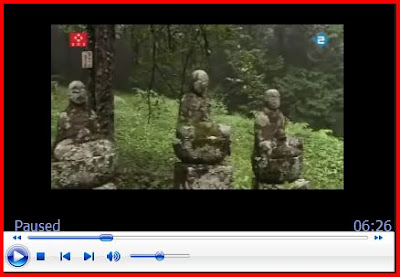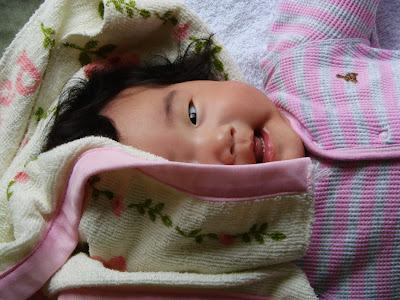It was a
rainy morning on Koya-san last year, my first day of walking on the 1200 km Shikoku pilgrimage. After a dawn fire puja and then breakfast at the youth hostel I went to the main temple to observe the ceremonies for Ohana Matsuri, the Buddha's birthday. It was a rather underwhelming affair, as it was again yesterday at
Nanzoin, a Shingon temple in Fukuoka prefecture known for what they claim is the world's largest bronze statue.
 Breakfast in front of the town office
Breakfast in front of the town office
I decided to make a day of it and in the spirit of the pilgrimage rode my bicycle the 20km to Nanzonin. I left at dawn in order to avoid having to ride with too many cars and trucks through the most heavily developed and congested areas of the city. An hour's steady peddling took me as far as the town of
Sasaguri, where I stopped for a small breakfast.
 Sasaguri Pilgrimage Map
Sasaguri Pilgrimage Map
Once past the town the horizon begins to open up, the cookie-cutter mega-stores and apartment buildings giving way to rice fields, streams, mountains and the occasional temple. This mostly rural area caters to religious tourists with a pilgrimage route of 88 temples, copying exactly the number of temples, if not the breadth of its route, as the long-established Shikoku trek. On both pilgrimages the temples belong largely to the Japanese school of tantric Buddhism known as
Shingon, though in the smaller area of Sasaguri there are only two dozen full-scale temples. The other 60 or so are nothing more than huts with a statue, incense pot and candle holder, place markers established to fill out the route, which I was told takes most pilgrims only three days to walk.
 Kobo Daishi at Henjoin (#62)
Kobo Daishi at Henjoin (#62) Henjoin (#62)
Henjoin (#62)
 The altar at Sanouji (#65)
The altar at Sanouji (#65)
 The road from Sanouji
The road from Sanouji
Between the town of Sasaguri and Nanzoin I stopped at a few temples to make offerings and take photos. By the time I got to Nanzoin it was only 09:00 and many of the shops and businesses were just opening. More than a few of the locals said, oh, you're the guy riding that bike. It's not too often, I suppose, that a foreigner comes riding into Sasaguri, especially on a bike like mine.





I wandered around a bit taking photos of the temple, the grounds, and the nehanzo, the reclining Buddha. According to a pamphlet I was given, the statue is 41m in length, 11m tall, weighs 300 tons, and is the world's biggest bronze statue, a claim which is not easy to verify through a quick
google search. It also claims to house ashes of the Buddha, Ananda, and Moggallāna (but not Sariputta).


 Deity cards from each of the 88 Shikoku temples
Deity cards from each of the 88 Shikoku temples
Inside the building that functions as the base of the statue is a long narrow hall fitted with 88 tiles under which is said to be soil taken from the respective number temple on the Shikoku pilgrimage. By taking tiny steps, placing one foot on each of the tiles, one may in theory, as the women working the counter told me, walk the Shikoku pilgrimage. It's just a little different, isn't it, I asked, but she just smiled.



Just before 11:00 people started showing up in front of the nehanzo, most of them far older than me. Four priests in electric blue robes arrived to lead a short sutta reading before a temporary altar, after which visitors were asked to make offerings by pouring sweet tea over the statue of the baby Buddha. Everyone then shuffled over to the refreshment table for manju and tea. And that was about it for the ceremonial part of the day.
 The dam from the road from Sanouji (#65)
The dam from the road from Sanouji (#65)
 View from the dam
View from the dam

On the way home I stopped by the
Narufuchi Dam, the creation of which has resulted in a wonderful lake with little human development around it. Unfortunately, it appears recreational accommodations were not part of the design, at least in the areas I could see, which included steep rocky banks and a fence around the entire circumference. The road leading up to the dam is not too steep and I was able to pedal to the top. The ride down was short but sweet.

If you're heading out that way and looking for a place to eat that doesn't include Royal Host, Joyful, Skylark, West, McDonald's, KFC, Mos Burger, or any of the other processed food chains, which seem to constitute the majority of eateries along 607, then you might like to try
Sobakiri Ouka, a one-man diner specializing in tempura and soba and happy to meet the needs of gaijin vegetarians. He also hosts a monthly live jazz event.
If you have any suggestions for next year's Ohana Matsuri, I'd be happy to receive them. An email form is available on my main blog,
Full Thangka.

#











































